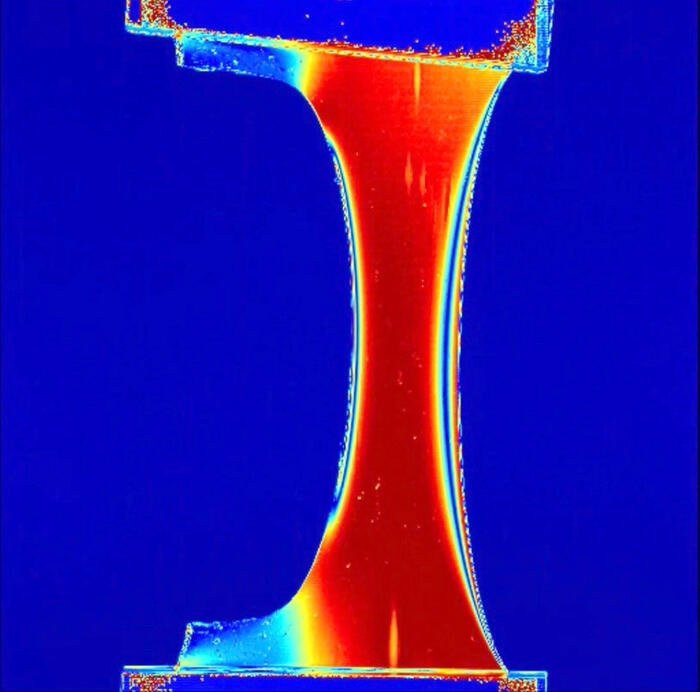Koichi Mayumi, an Associate Professor at the Institute for Solid State Physics, University of Tokyo, and Kohzo Ito, a Professor at the Graduate School of Frontier Sciences, University of Tokyo, developed the first self-reinforcing gel that can immediately recover; the gel became sturdy when pulled and returned to its original state upon relaxation. Associate Professor Mayumi commented, "We seek to apply this gel to artificial ligaments and joints. " A report on these findings was published in the journal Science.
The developed gel has high expectations for application in a range of products. Polymer gels are employed for various applications in our daily lives, such as in jellies, contact lenses, and water-absorbent diapers; however, most of these gels are extremely fragile. Various high-strength gels have been developed since 2000, including a ring gel (connecting polymer chains with a ring of molecules), double network gel, and Tetra-PEG gel (developed by Professor Ito and others). However, conventional high-strength gels cannot be applied to artificial ligaments and artificial joints because these cannot achieve both the toughness and immediate recovery characteristics required for these applications. This is because the strength of the high-strength gel is maintained by introducing a fragile bond, called a sacrificial bond, inside the polymer gel. Deformation of the sacrificial-bond-containing gel selectively breaks the sacrificial bond, dissipating the input mechanical energy and as a consequence, more energy is required to break the gel. However, as the sacrificial bond is broken at the time of deformation, this bond cannot be restored, and requires some time to recombine. Even if considerable time is provided for recovery, the recovery rate will be less than 50%, such that the immediate recovery required for artificial joints cannot be achieved.
The high-strength gel developed in this study is tough and recovers immediately via the self-reinforcing effect, which is a new toughening mechanism that does not involve bond breakage as in the case of conventional high-strength gels. Associate Professor Mayumi explained, "We were originally investigating ring gels, but at one point during our research, our students prepared gels, which usually have molecular concentrations of around 10%, with higher concentrations. We analyzed these structures with X-rays because they appeared to possess interesting properties, which ended up being the result of a reduction in the cyclic molecules. The conventional ring gel has a cyclic molecular coverage of 25% and polymer concentration of approximately 10%, whereas the self-reinforcing gel developed here has a cyclic molecular coverage of 2% and polymer concentration of 25-50%. When various experiments were conducted to investigate the performance of the new gel, the fracture elongation ratio was found to be 13 times higher, and the fracture stress increased to 5 MPa compared to those of the conventional gel. Additionally, when investigating the property of immediate recovery, when the gel was thinly stretched and shot with a BB gun bullet from a gas gun, the bullet penetrated the conventional gel but bounced off the new gel without penetrating it, following which the gel returned to its original state. Upon detailed analysis, the immediate recovery rate was found to be 100%, and the toughness (energy that can be withstood before destruction) had increased from 160-550 kJ/m3 to 6600-22,000 kJ.

Credit: ISSP, UTokyo
How was this performance achieved? As the number of cyclic molecules in this gel is less than that in the ring gel, the polymer chains accumulate during elongation and undergo crystallization (elongation-induced crystallization). Elongation-induced crystallization is the origin of toughness in natural rubber; however, this is the first report describing the discovery of reversible elongation-induced crystallization in solvent-containing polymer gels. The toughness and self-healing property were confirmed. A typical ring gel will break immediately if pulled with a notch that penetrates halfway through the material. However, the new gel stretched without breaking and returned to its original state. Associate Professor Mayumi added that they will work with the University of Tokyo Hospital, Tokyo Institute of Technology, and Nagoya University through the CREST program "Elucidation of the robust toughening mechanism of gels and development of artificial tendons and ligaments " to apply the gel to biomedical materials. He concluded, "We used a ring gel this time, but if we can deform the polymer chain uniformly, we surmise that the self-reinforcing effect induced by elongation-induced crystallization can be applied to other network structures. We would like to focus on developing this gel in response to this idea."
This article has been translated by JST with permission from The Science News Ltd.(https://sci-news.co.jp/). Unauthorized reproduction of the article and photographs is prohibited.




